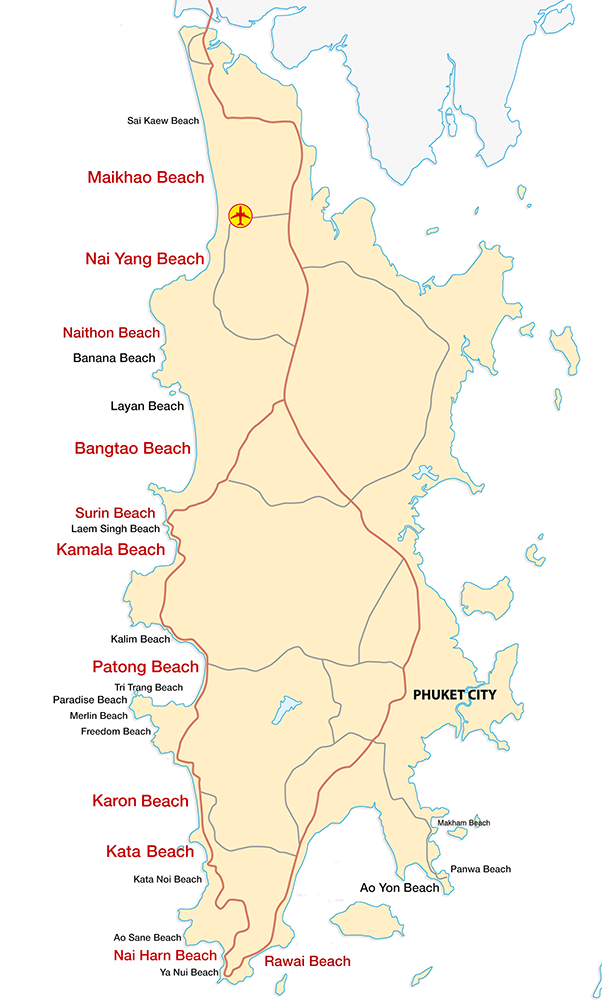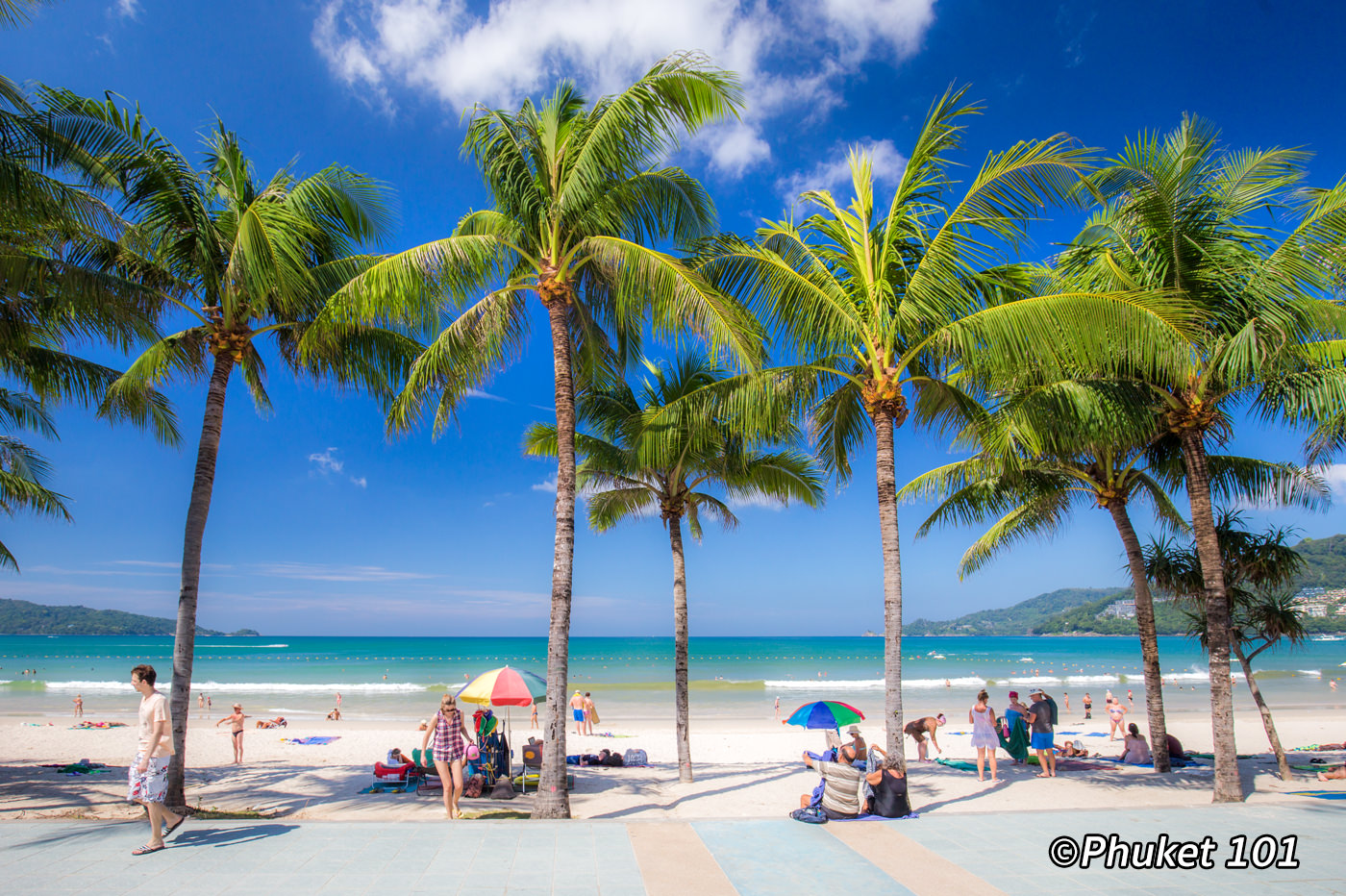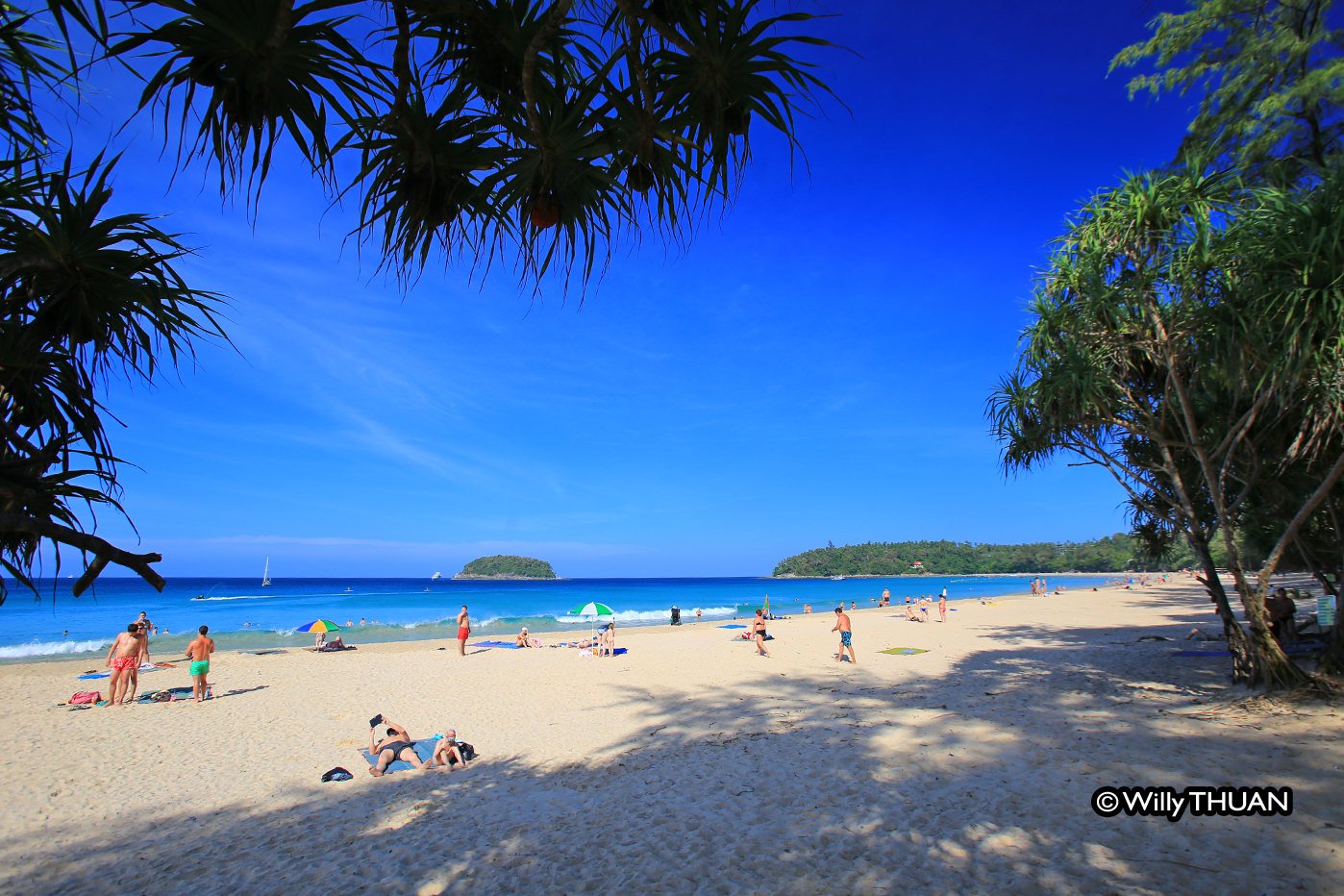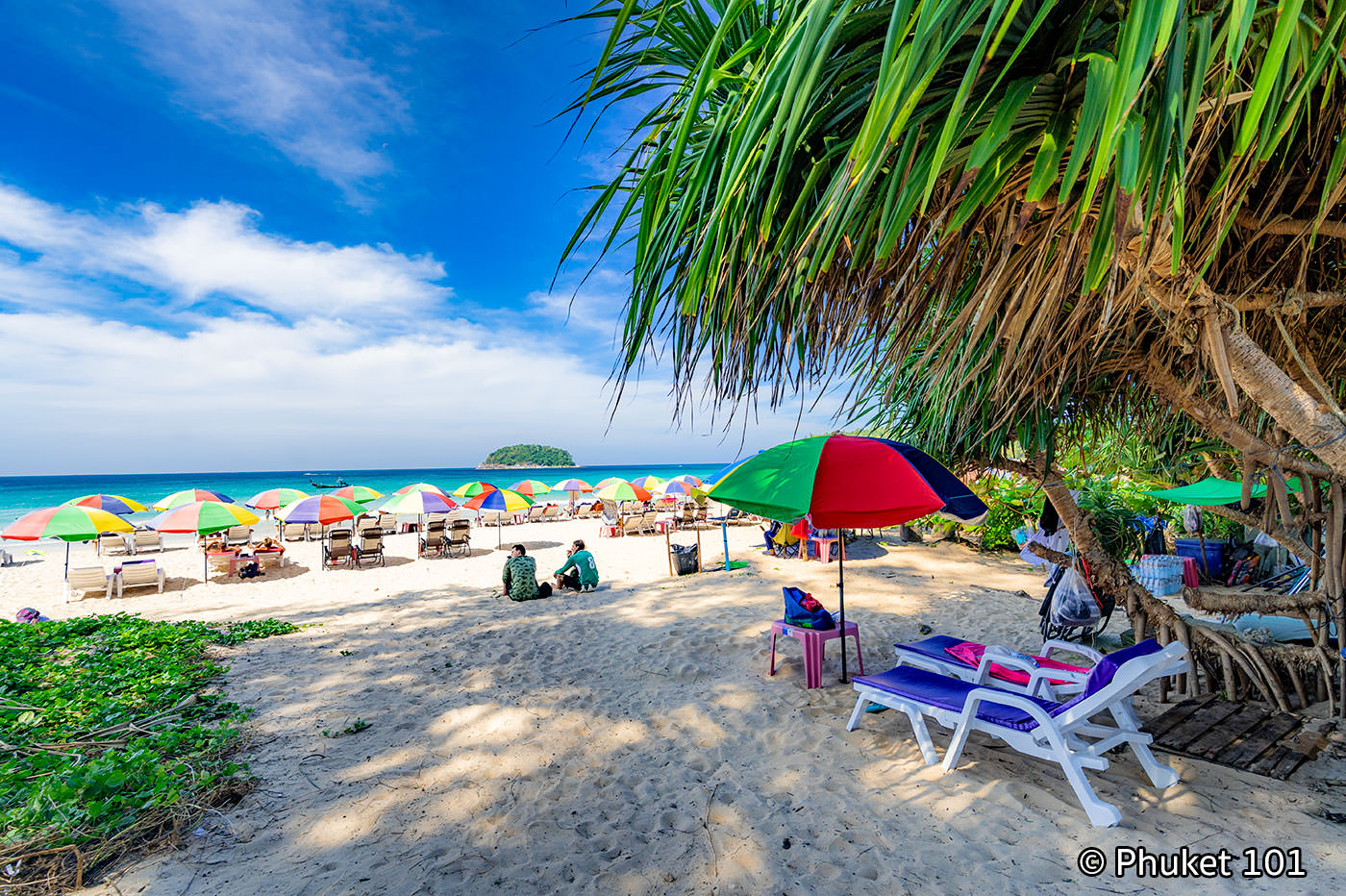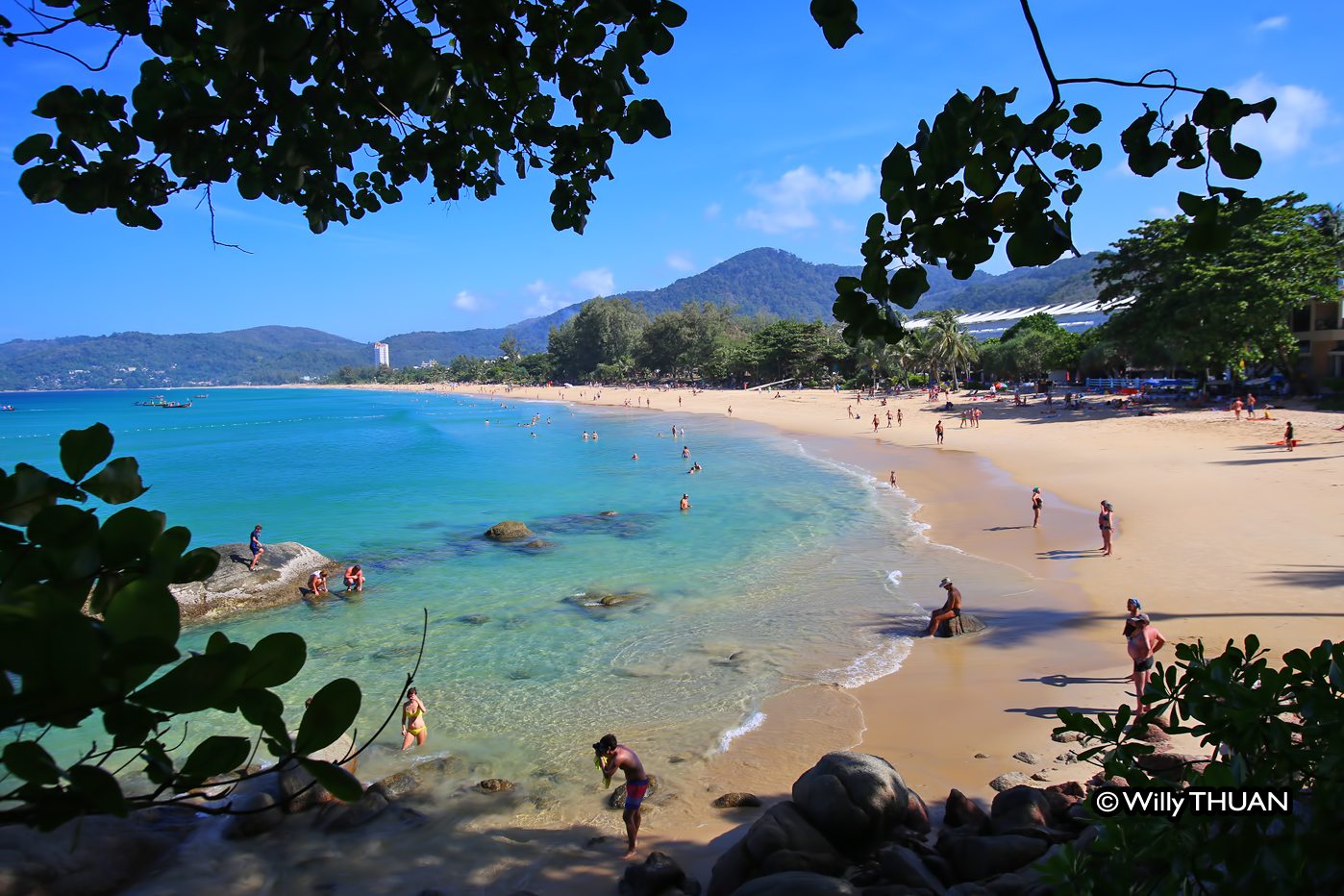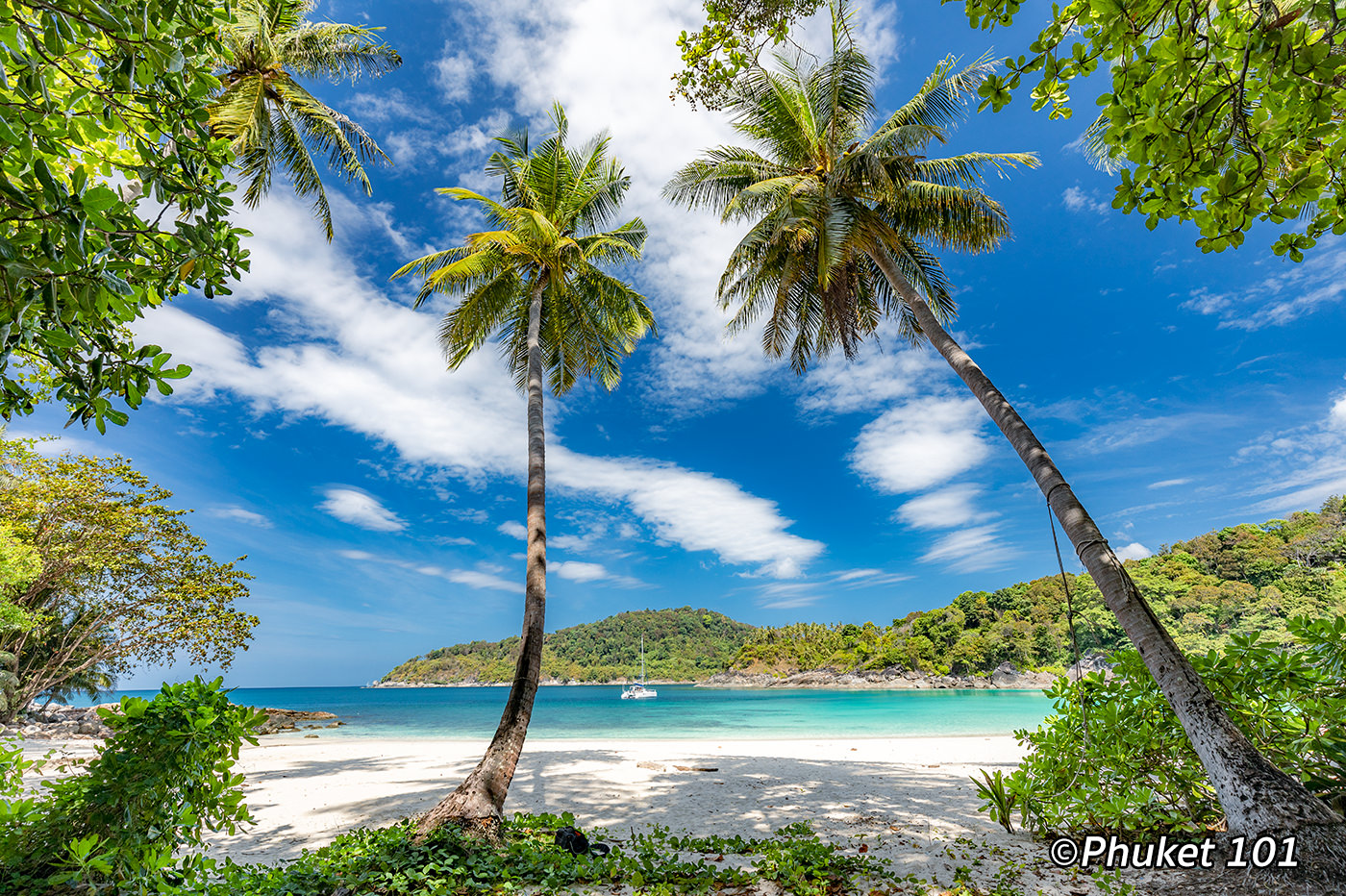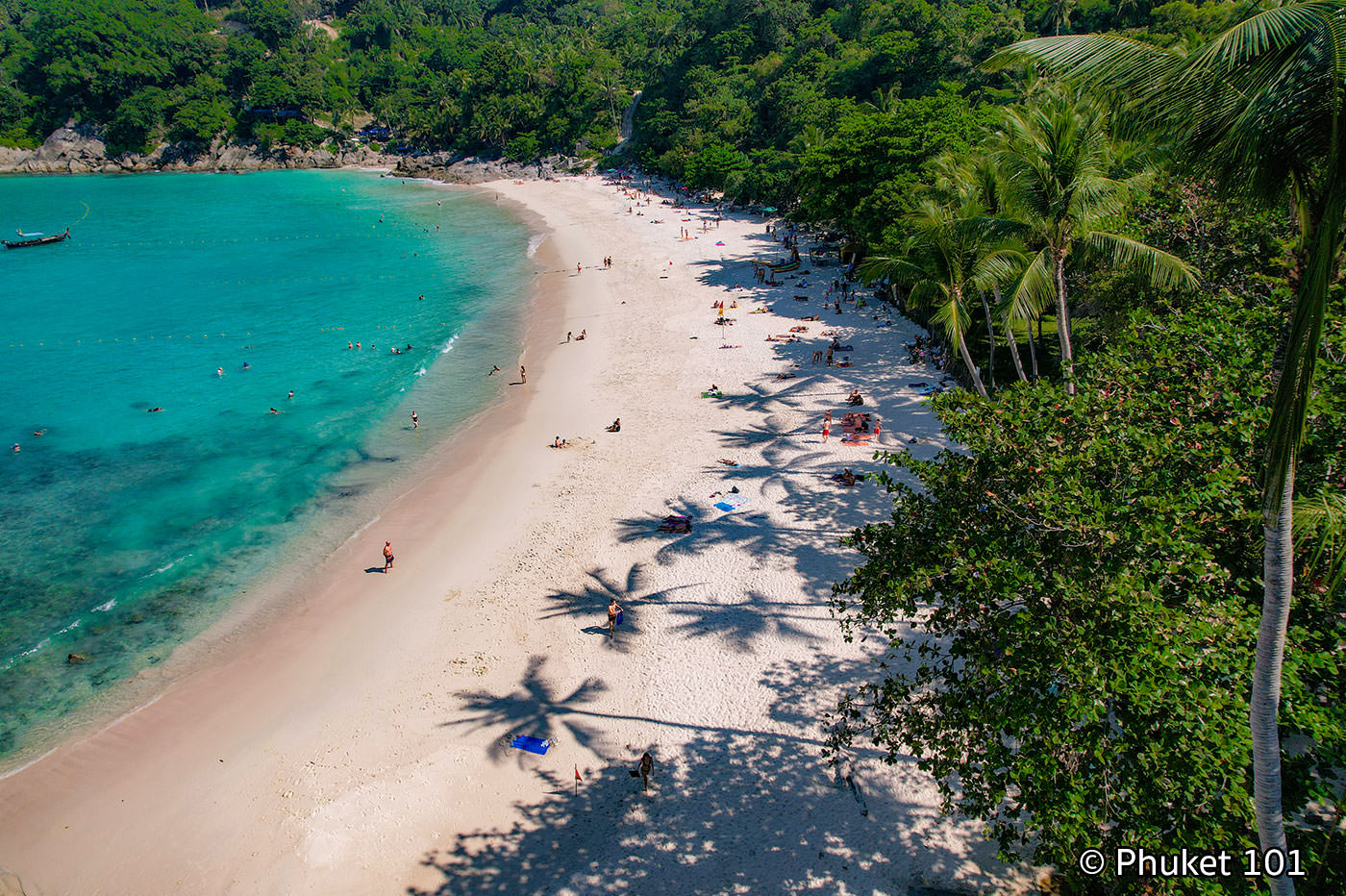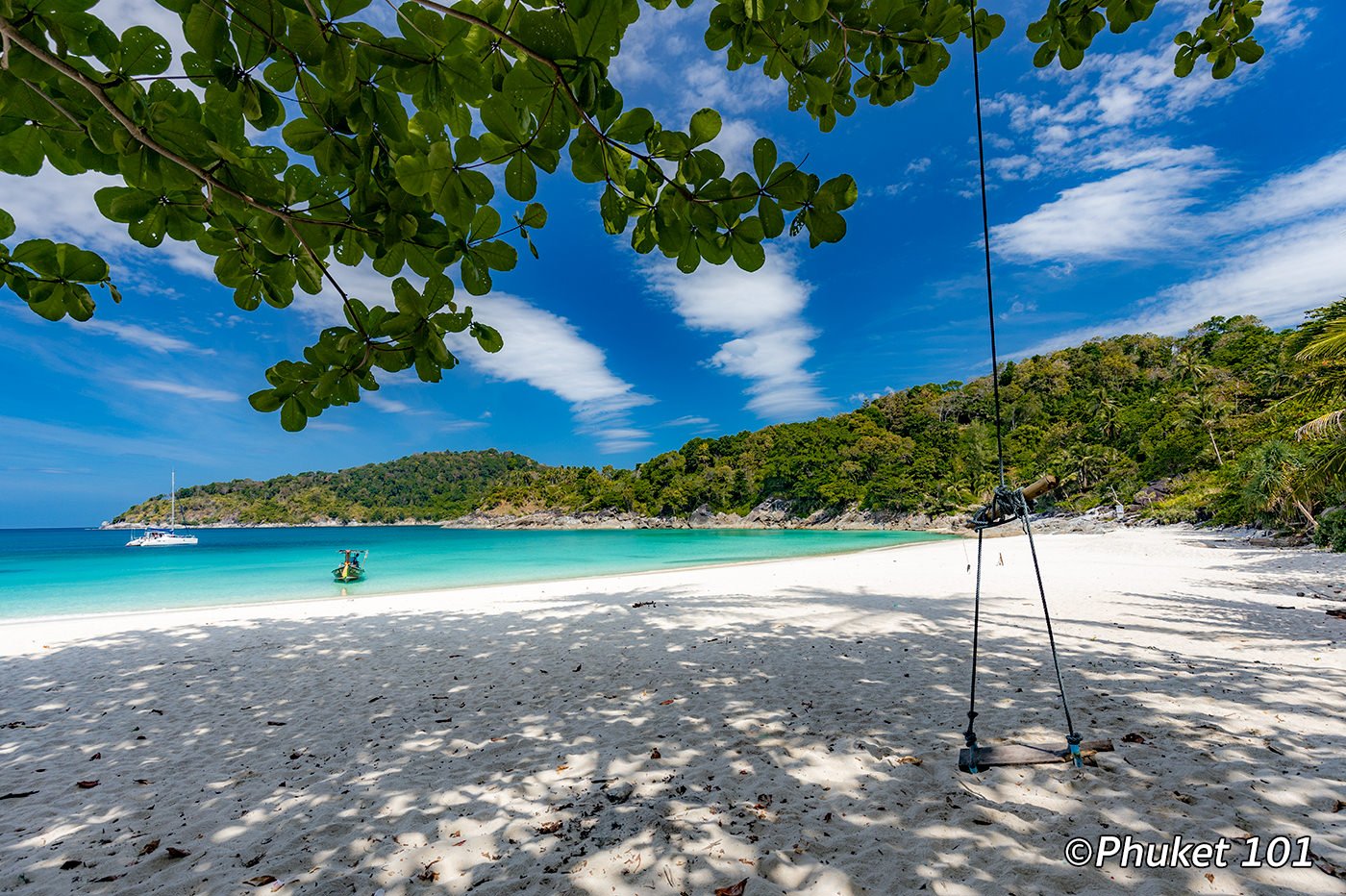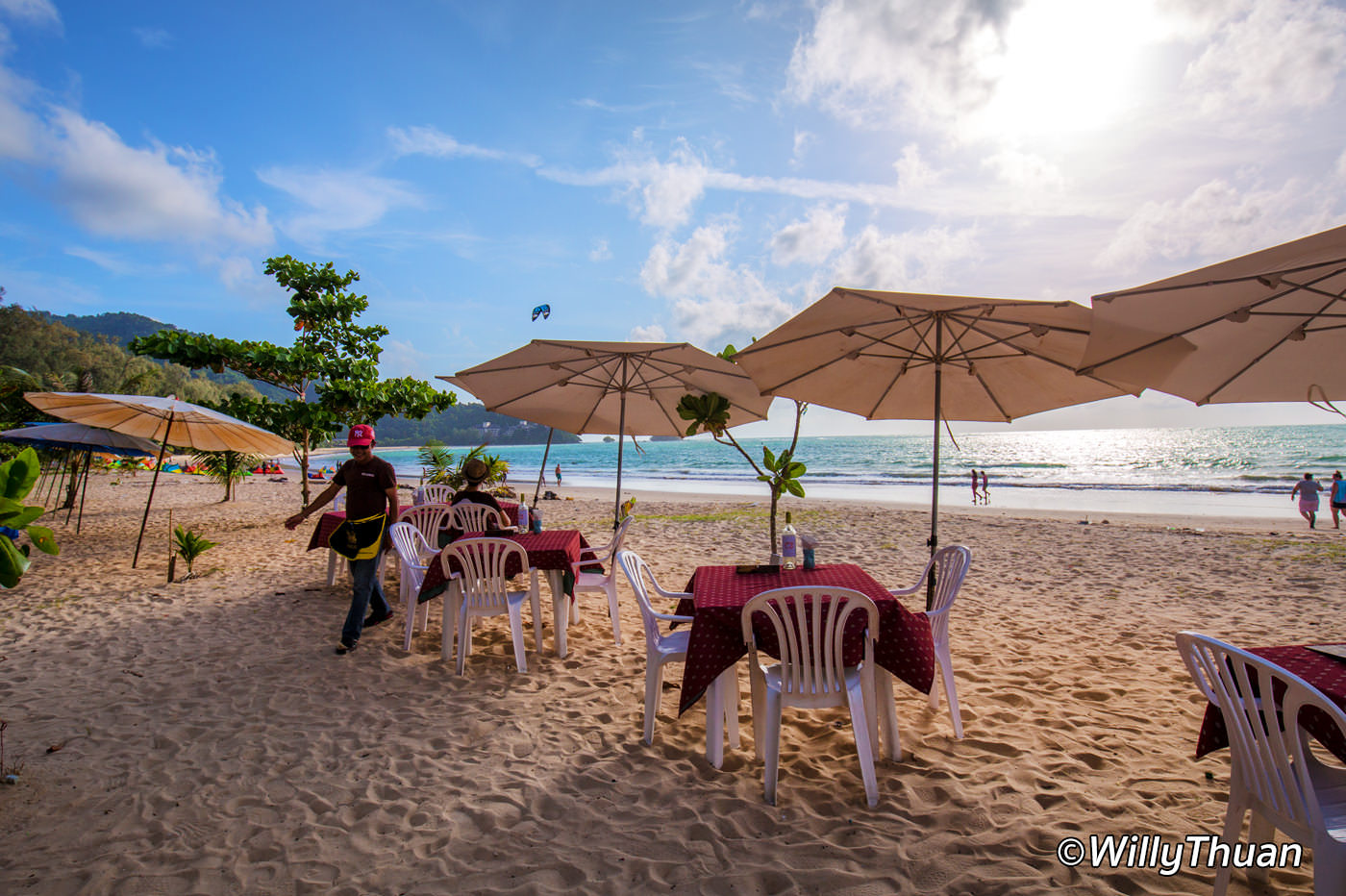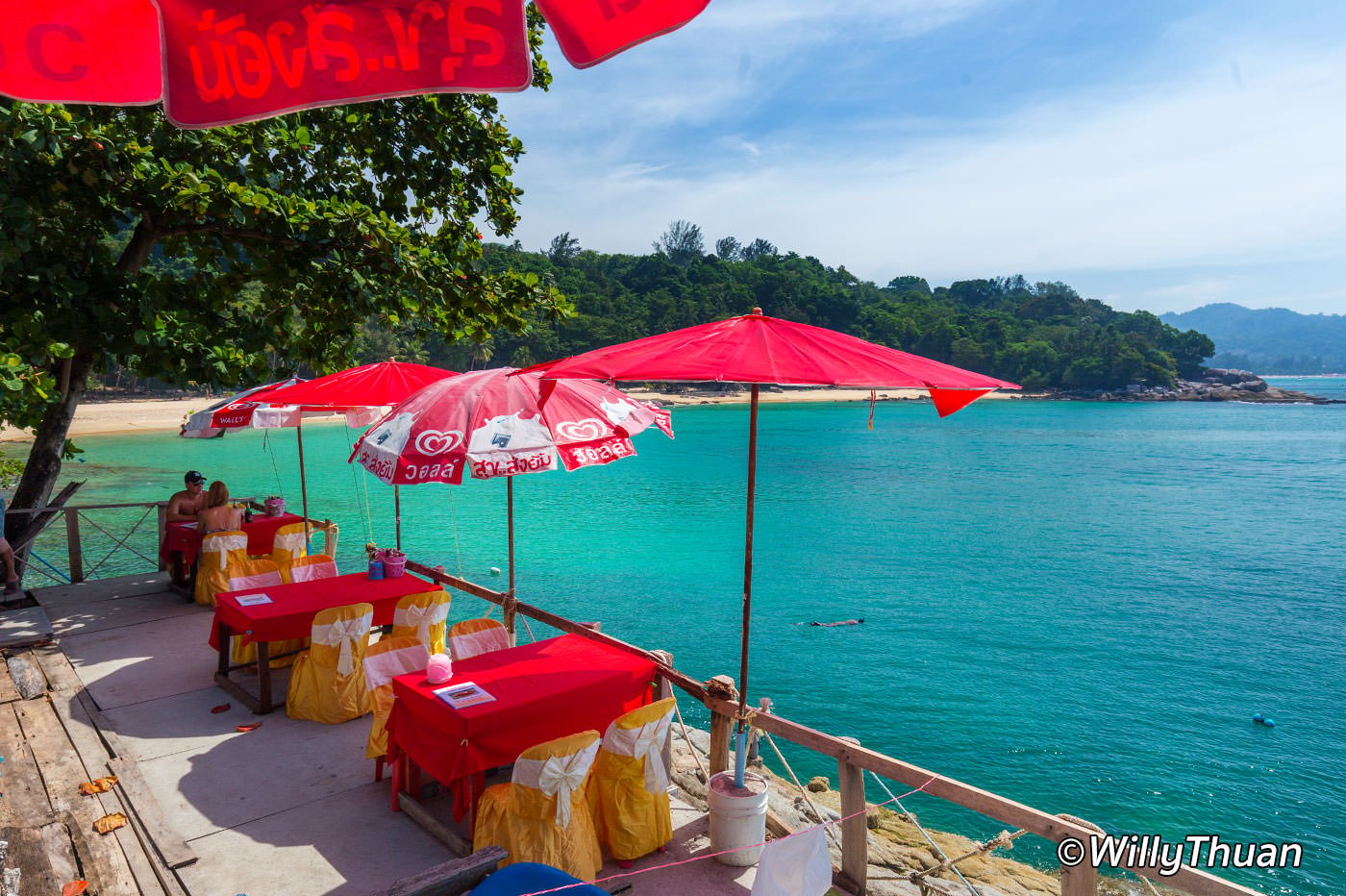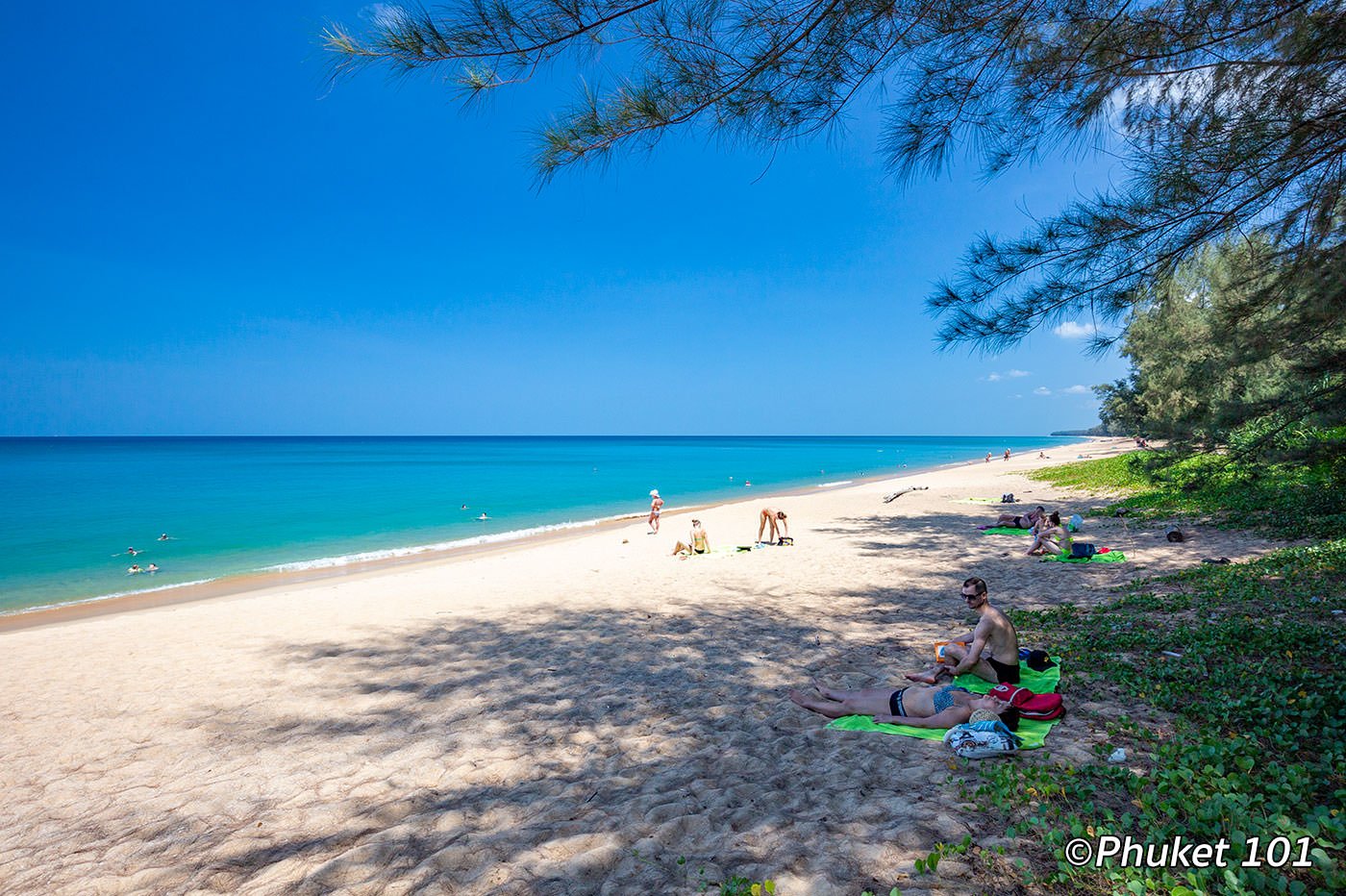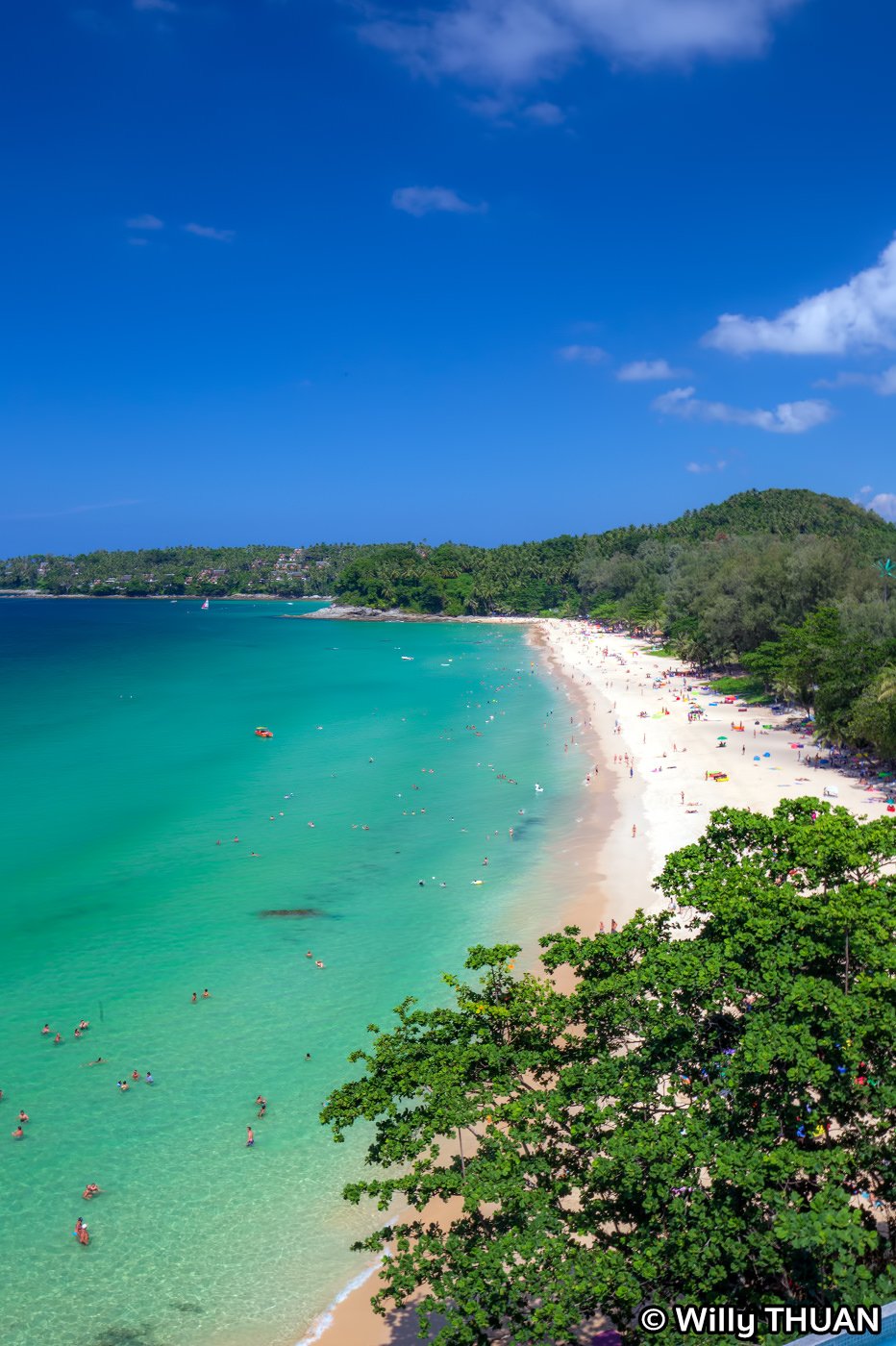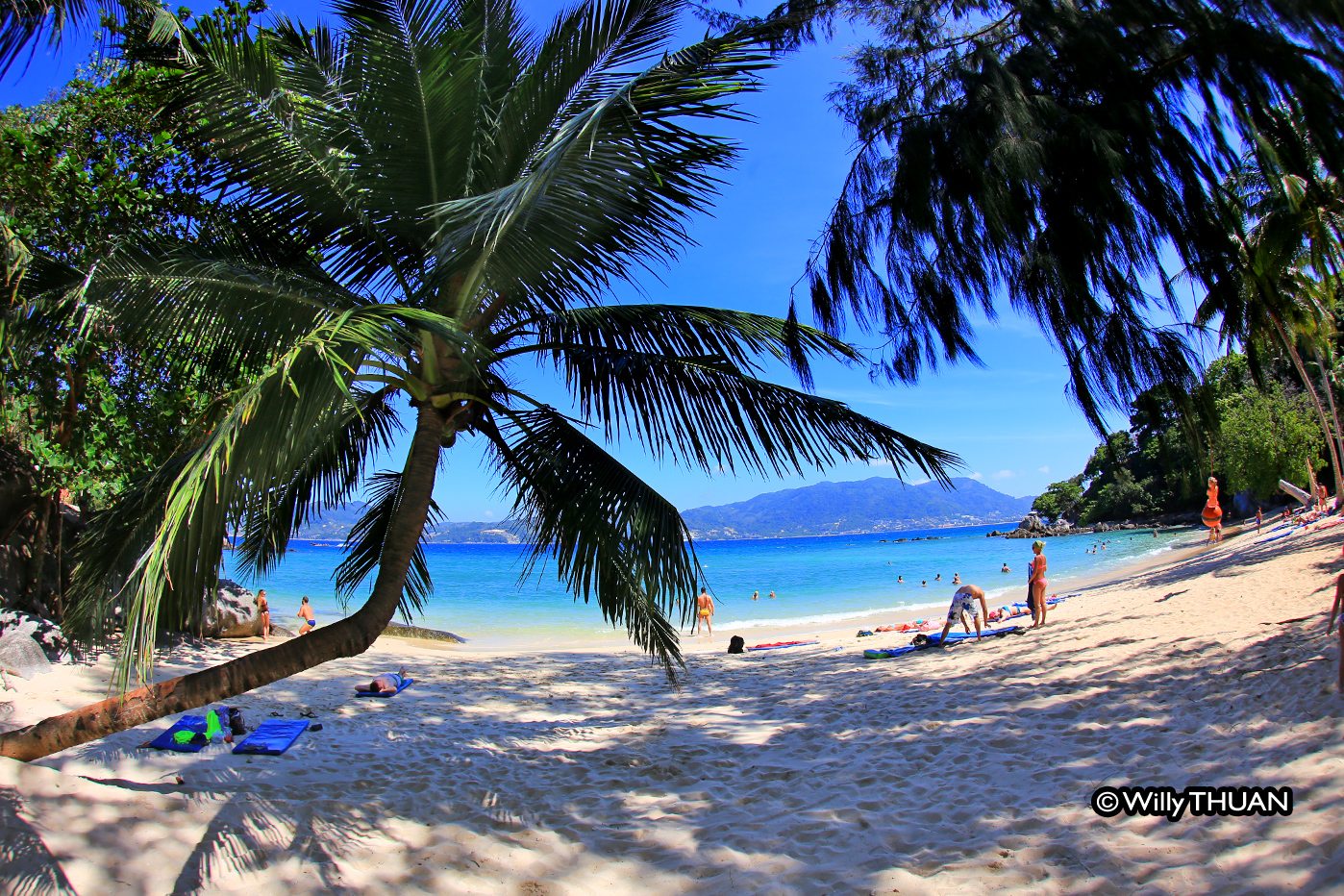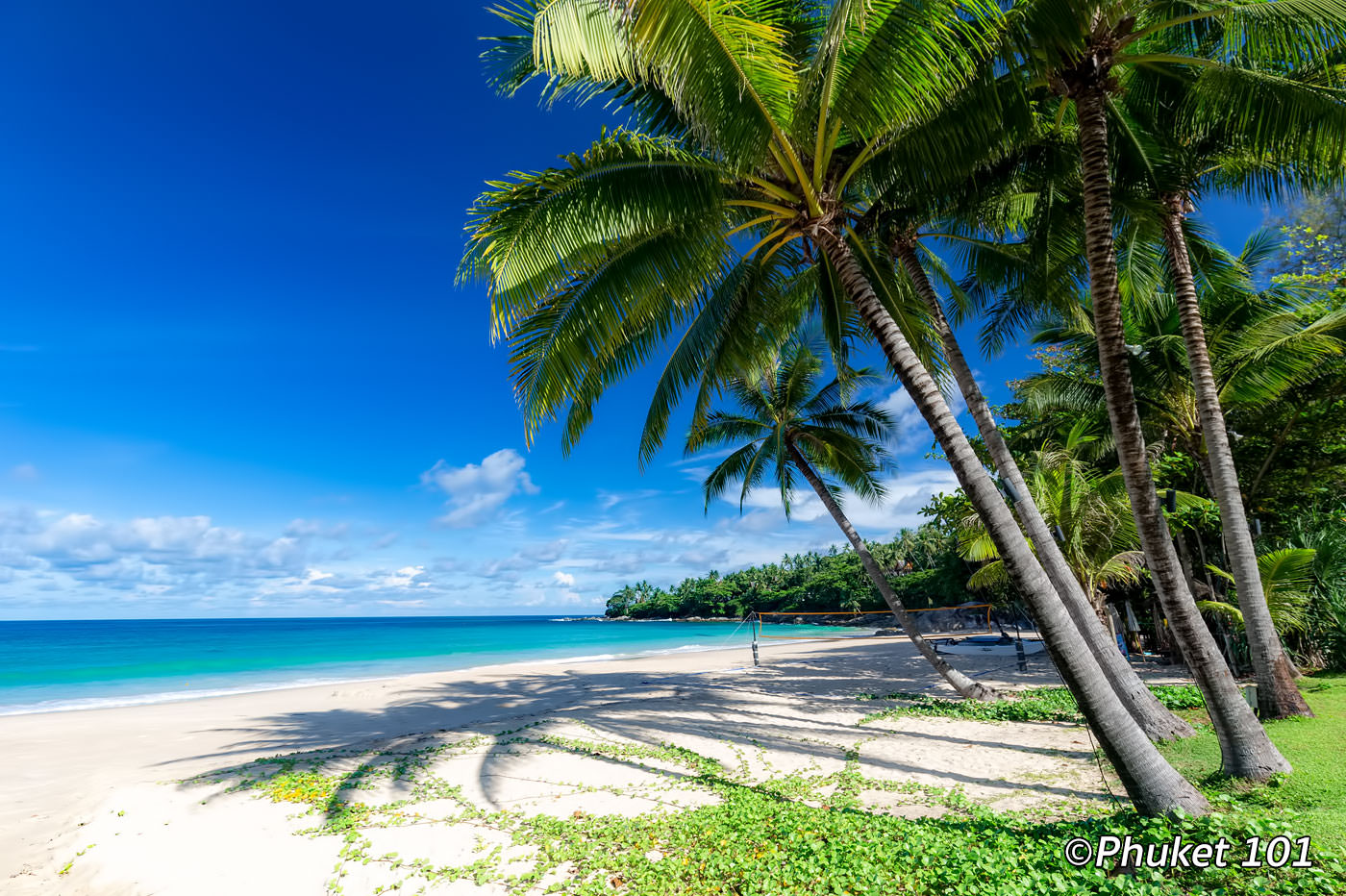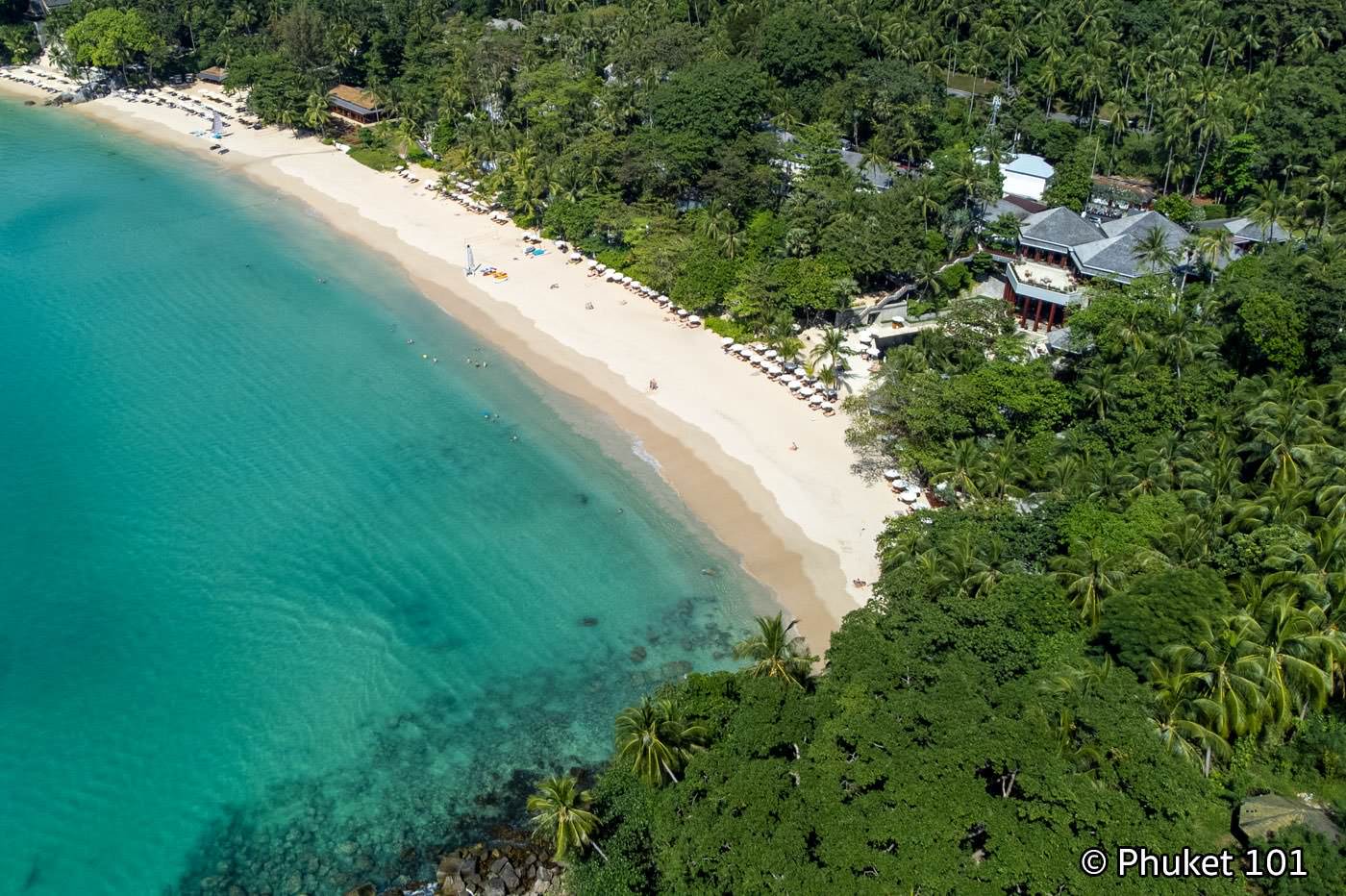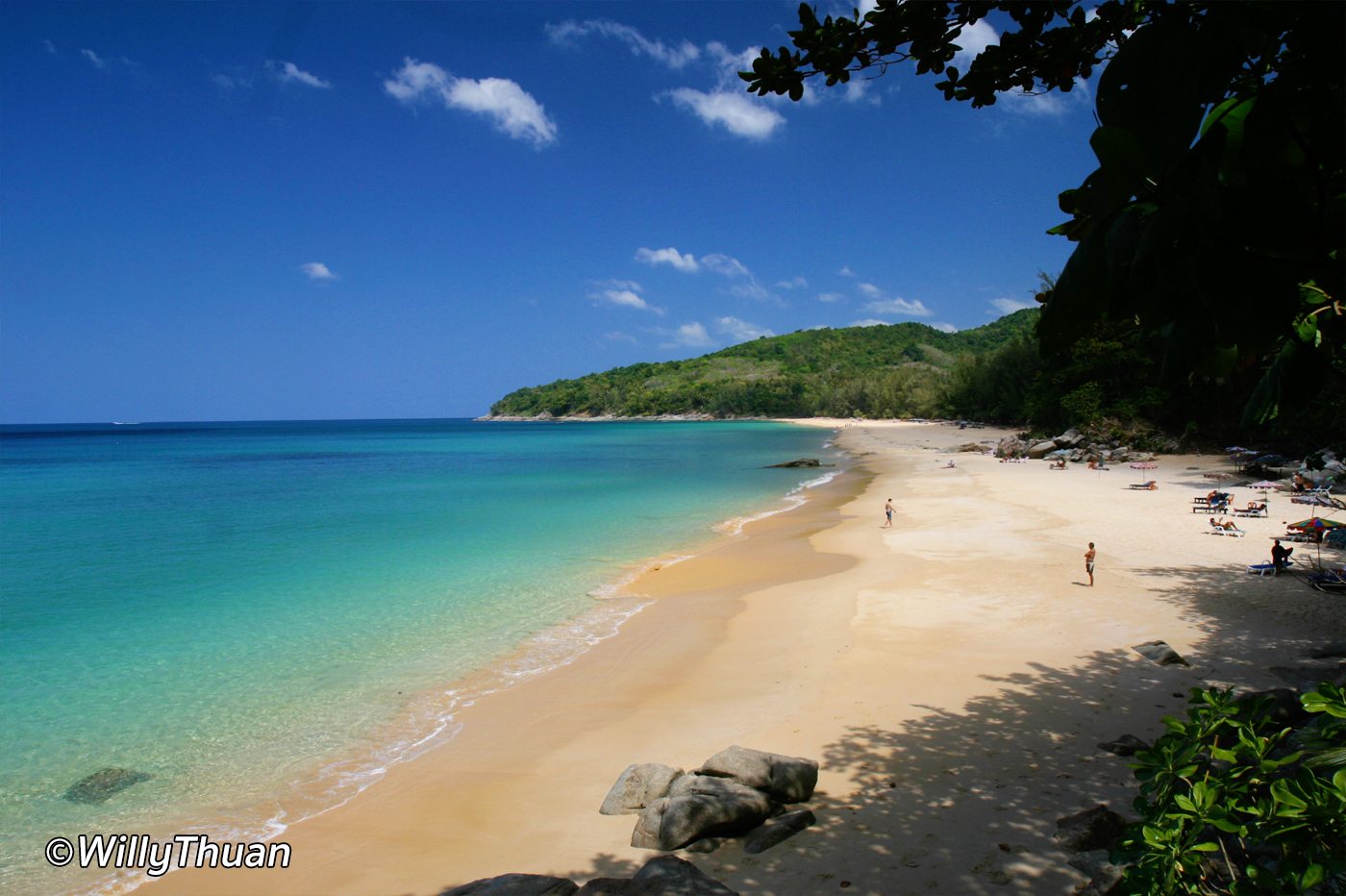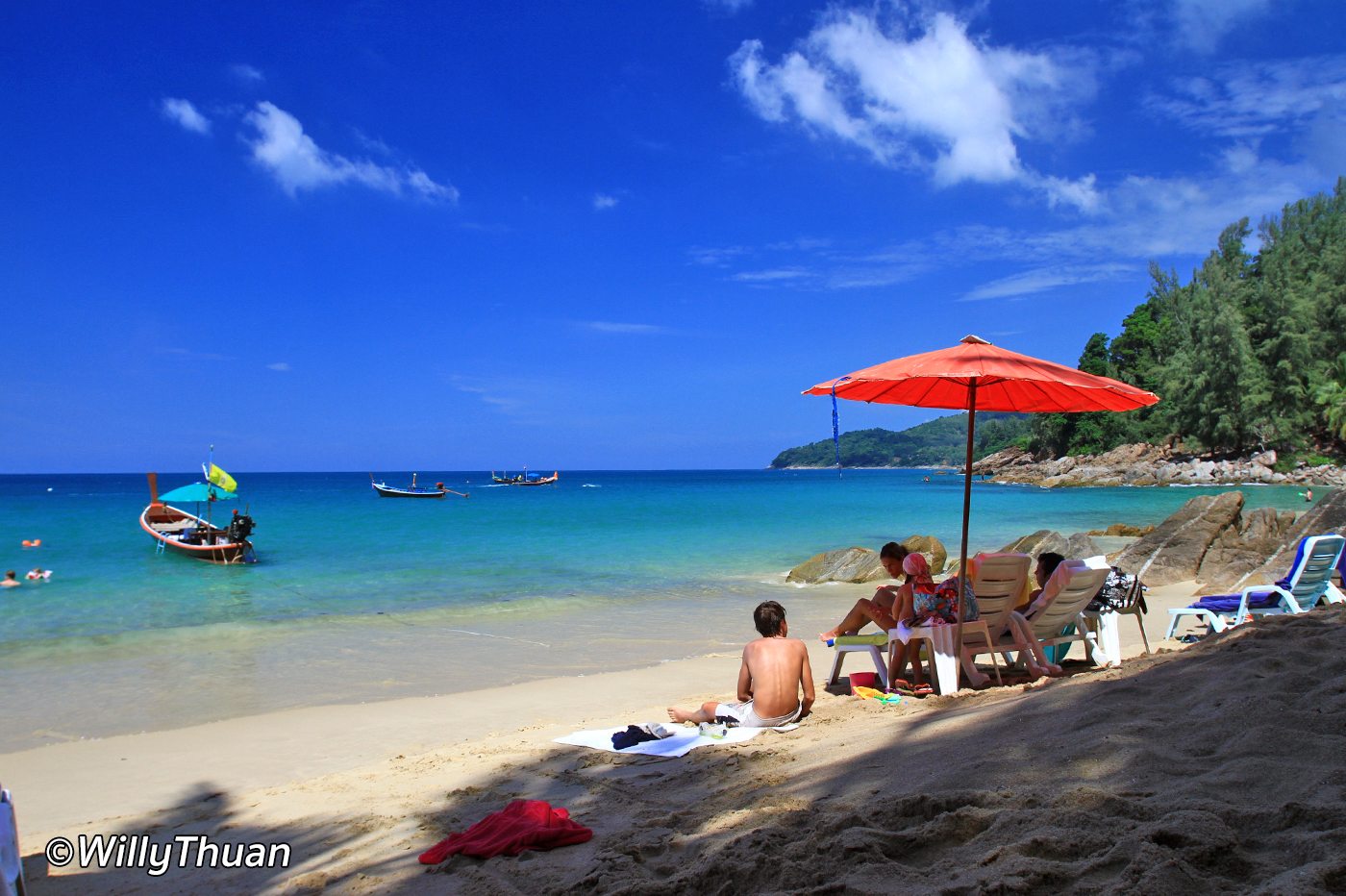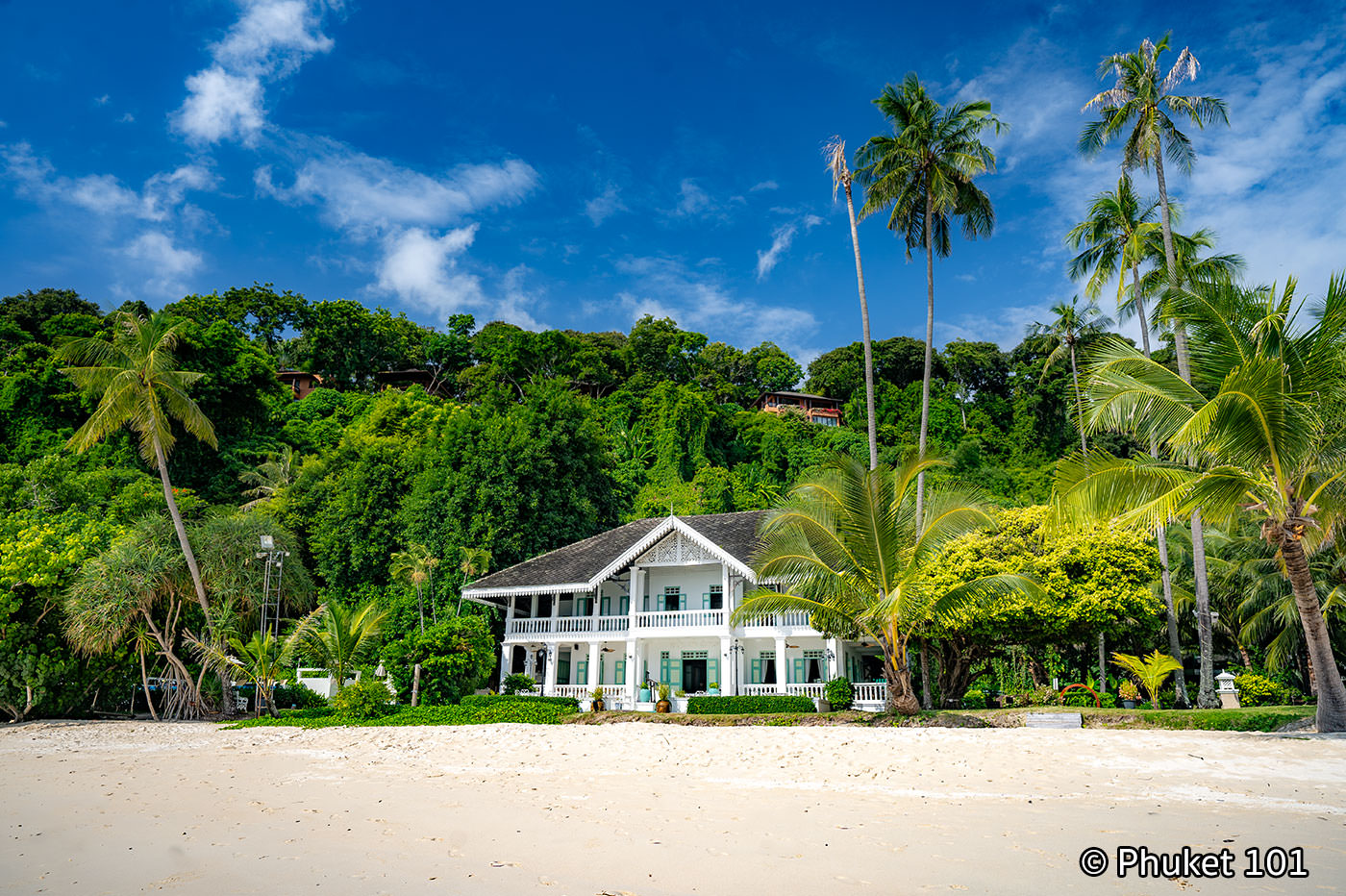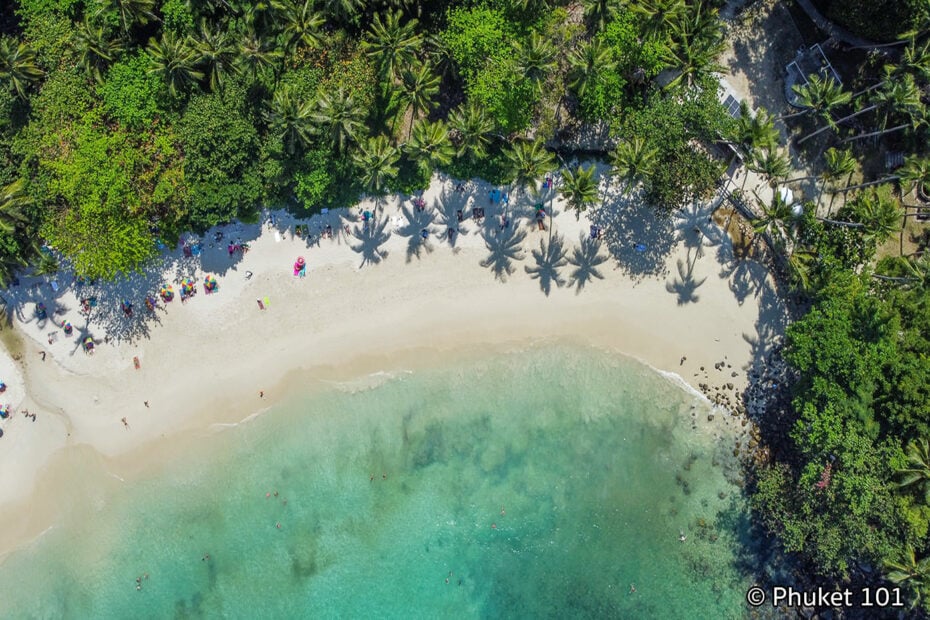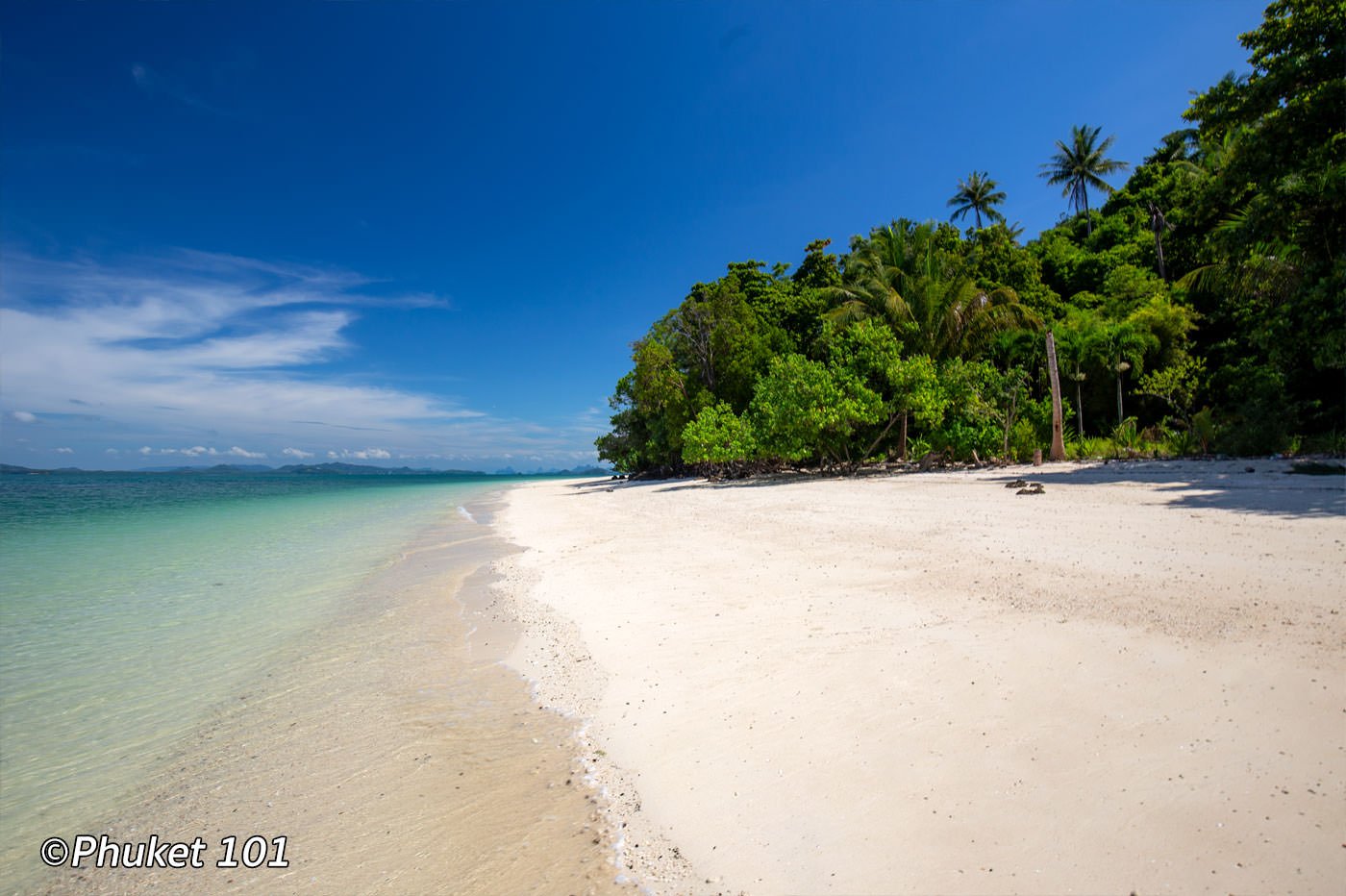What are the most beautiful beaches in Phuket?
Phuket is famous for its beautiful beaches, but “what is the best beach in Phuket?” is a question I hear all the time. After living here for 30 years and exploring every stretch of sand, I’ve learned that the answer depends on what you’re looking for. Some travelers want a fun beach with restaurants and nightlife, while others seek a quiet escape far from the crowds. In the 30 years I lived here, I enjoyed all kinds of beaches – from the busiest party shores to the most secluded hidden coves – each for different reasons.
Types of Beaches in Phuket: In my experience, Phuket’s beaches fall into a few groups:
-
Main Tourist Beaches: These are the popular beaches where many people book their hotels. They have plenty of restaurants, shops and bars nearby. Beaches like Patong, Kata, Karon, Kamala, or Bang Tao are super convenient and lively, though they can get crowded in high season.
-
Day-Trip Beaches: These beaches have little to no accommodation – people come just to enjoy the day. They often have the softest sand and clearest water, plus a more peaceful vibe than the main hubs. I love going to spots like Nai Harn, Freedom Beach, Surin, or Ya Nui for a relaxing lunch with a sea view and a swim.
-
Hidden & Remote Beaches: These are the secret beaches that many visitors miss. Often located in the north or at the end of dirt roads, they require a bit of effort (maybe a scooter ride or a hike) to reach – but that’s part of the adventure! These quiet spots are my personal favorites when I want a few hours of solitude.
-
‘Private’ Beaches: Legally, no beach in Thailand is truly private. But if a resort owns all the land around a beach, it can limit access, effectively keeping it for its guests. These exclusive beaches are usually pristine and uncrowded. (Don’t worry, I’ll mention how to visit if you’re not a guest, when possible.)
In this guide, I’ll share 20 of Phuket’s most beautiful beaches, with my own experiences and tips for each one. Consider me your local friend, guiding you to the shores I love. Whether you want to party all night, build sandcastles with your kids, find the best snorkelling, or simply watch a breathtaking sunset in peace, there’s a beach here for you. Let’s start our journey along Phuket’s coastline!
Phuket Map and Beaches Locator
Our Phuket Beach Guide Map will help you locate the many beaches and visualise our small island’s geography.
Patong Beach
| Main Tourist Beach / Nightlife Hub (West Coast) |
Patong Beach is Phuket’s most famous beach – the bustling heart of the island’s tourism. It’s a large, crescent-shaped bay about 3 kilometers long, with soft white sand and a busy scene of people swimming, sunbathing, and enjoying water sports.
Now, I’ll be honest: Patong is not where you go for a quiet, relaxing beach day. This is the place for action – jet skis buzzing on the water, parasailers up in the sky, beach volleyball games, and vendors wandering by selling ice cream or offering to braid your hair.
The central part of the beach can get very crowded in high season, with rows of beach chairs and umbrellas (yes, you can rent one to lounge on if you like). It’s lively, chaotic, and full of life. When I first moved to Phuket, Patong was one of the first beaches I saw, but these days, I don’t swim here often (I prefer quieter waters), but I do enjoy Patong in the early morning – it’s surprisingly peaceful, with just a few joggers on the sand and the sea almost empty.
Kata Beach
| Main Tourist Beach (West Coast) |
Kata Beach is a popular favorite for many travelers – and for good reason. This beautiful bay on the west coast offers a bit of everything that makes Phuket beaches special. The sand at Kata is golden and soft, the water is clear and turquoise during high season, and the beach is framed by lush green hills at either end.
At about 1.5 km long, Kata is big enough that you can usually find a spot to lay your towel without feeling overcrowded, especially towards the ends of the beach. I often recommend Kata Beach to families and first-timers in Phuket because it has a relaxed, friendly vibe with plenty of conveniences nearby. I’ve spent countless weekends here, swimming in the gentle waves and enjoying the view of little Pu Island that sits offshore. It’s the kind of place where you can take a long barefoot walk, stop for a fresh coconut from a vendor, and let the kids splash in shallow water safely.
One thing I love about Kata is that it changes character with the seasons. In the sunny high season (November to April), the bay is generally calm, perfect for swimming and even snorkelling along the rocks. In the low season (May to October), bigger waves roll in, turning Kata into a mini surfing hotspot.
You might see locals and expats riding the waves or taking surf lessons, especially at the south end of the beach. I tried surfing here once; let’s just say I spent more time falling off the board than riding it, but it was a lot of fun! If you’re not into surfing, note that low-season swimming can be dangerous at times due to rip currents, so pay attention to red flag warnings.
Karon Beach
| Main Tourist Beach (West Coast) |
Just south of Patong and Kata, you’ll find Karon Beach, one of Phuket’s longest and most beautiful beaches. Karon stretches for almost 3.5 kilometers (making it the third-longest beach on the island) and is so wide in parts that it never feels full, even in the middle of high season. I often come to Karon when I want long walks by the sea without bumping into too many people. The sand here is golden-white and famously known as “singing sand” – it actually squeaks under your feet when you walk on it, thanks to its high quartz content. It’s a little quirky detail I enjoy sharing with friends: take off your shoes and shuffle a bit, and you’ll hear the sand sing!
The water at Karon is a gorgeous blue on sunny days, and the beach has a gentle slope into the sea. During the dry season, the sea is usually calm and great for swimming or even snorkelling near the rocky ends. But I must warn you, in the monsoon season (May–October), Karon can have strong waves and dangerous currents. The beach is quite open to the sea, so big waves roll in, and there are often red flag days when it’s unsafe to swim. Lifeguards do patrol and put up flags, so always heed their warnings – every local knows Karon’s beauty comes with a bit of respect for Mother Nature.
Nai Harn Beach
| Day-Trip Beach / Local Favorite (Southwest Coast) |
Tucked in the southwest corner of Phuket, Nai Harn Beach is often cited as one of the most beautiful beaches on the island, and I wholeheartedly agree. It’s a fairly small beach by Phuket standards – a lovely cove maybe 700 meters long – with powdery white sand and stunning blue water in the dry season. What makes Nai Harn special to me is its natural, almost untouched atmosphere. Green hills surround the beach, and there’s a large freshwater lake and park just behind the sand.
Unlike the big tourist beaches, Nai Harn has only a handful of hotels and no town to speak of right by the beach, which has helped it retain a lot of its original charm. In fact, when I first visited Nai Harn in the 1990s, it looked quite similar to how it looks today. The area is somewhat protected (there’s a temple and royal-funded park nearby that prevented overdevelopment), so it hasn’t been overrun with buildings. Many locals (and long-term expats like me) consider Nai Harn our go-to beach on weekends for a relaxing day out.
Kamala Beach
| Main Tourist Beach (West Coast, family-friendly) |
Kamala Beach is a calmer alternative to the buzzing beaches like Patong. Located just north of Patong, Kamala has transformed over the years from a sleepy fishing village into a relaxed resort town, all while keeping a more laid-back vibe. The beach itself is a long, curving bay about 2 kilometers in length, with fine, light golden sand and clear water in the high season. One of my personal pleasures is taking an early morning walk along Kamala Beach – the bay is usually calm like a mirror, and you can see fishermen casting nets or locals doing yoga on the sand.
There’s a line of tall coconut trees along parts of the beach, providing that classic tropical look (and some nice shade patches later in the day). The south end of Kamala is near a small river inlet and is very quiet, while the north end has become known for some upscale beach clubs and resorts. Overall, Kamala is popular with families, retirees, and those who want a peaceful stay that’s not too far from the action in Patong.
Kata Noi Beach
| Quiet Beach / Semi-Private (West Coast, south of Kata) |
Just a short hop over the hill from Kata Beach lies Kata Noi Beach, a smaller and quieter sister to Kata. “Noi” means “little” in Thai, and indeed Kata Noi is a small bay, roughly 700-800 meters long. This beach is a treasure for those who want the beauty of Kata but with far fewer people. I often recommend Kata Noi to friends who say, “I like Kata, but wish it were less crowded.”
The sand here is super soft and pale golden, and the water in high season takes on a brilliant shade of turquoise – even clearer, it seems, than Kata Yai (big Kata) just next door. In fact, Kata Noi once made it onto a list of the world’s most beautiful beaches, and when you stand on its shore, you’ll see why. The bay is surrounded by green hills in the back with a few rooftop restaurants at the top, but no towering buildings. It feels tucked away and almost exclusive.
Kata Noi has an upmarket and peaceful atmosphere. There are only a handful of hotels here, but they include some of Phuket’s best. Two luxury resorts – The Shore at Katathani (an adults-only pool villa resort) and the Katathani Phuket Beach Resort – occupy the southern end and middle of the beach, respectively, and they have direct beachfront access. The northern end has the boutique Mom Tri’s Villa Royale (perched on the rocky slope) and a couple of other smaller hotels on the hillside. Because of this setup, Kata Noi almost feels like a private beach for these resorts’ guests – but it’s absolutely open to the public, and I often stroll in via the public path next to Katathani Resort for a swim. Don’t be shy about visiting even if you’re not staying there.
Freedom Beach
| Hidden / Day-Trip Beach (West Coast, near Patong) |
Freedom Beach is one of my absolute favorite hidden gems in Phuket. Imagine a 300-meter stretch of incredibly soft white sand backed by lush jungle and coconut trees, with clear blue-green water gently washing up on the shore. It’s a little pocket of paradise, surprisingly close to the busiest part of the island. In fact, Freedom Beach lies just next door to Patong, but it feels a world away from the crowds. I first discovered it many years ago, and it still amazes me – even in the high season, it’s relatively quiet due to its relatively “secret” location. When I need a break from crowds, I come here to relax near crystal water, surrounded by nature.
Getting to Freedom Beach is an adventure in itself (and part of why it stays peaceful). There are only two ways to get there: by boat or on foot. During the dry high season (December to April), the easiest way is to hire a longtail boat from southern Patong. It’s a quick ride around the headland – you’ll usually pay around 1,200–1,500 baht for a round-trip (try bargaining or find other travelers to share the cost). The boat drops you right on the sand. In the low season (May to October), or if you’re feeling more adventurous, you can go by land – but be ready for a workout! You have to trek down a steep hillside path through the forest. I’ve done this hike a few times; it’s short (maybe 15-20 minutes) but quite steep and can be slippery, so wear good shoes.
Nai Yang Beach
| Remote / Quiet Beach (Northwest Coast, near airport) |
Nai Yang Beach holds a special place in my heart – it’s one of those beaches that I consider a hidden haven, even though it’s not far from Phuket International Airport. In fact, as the plane descends, you can often see Nai Yang’s golden strip of sand from above, curving gently along the coast north of the runway. Despite that proximity, Nai Yang feels remote and remains wonderfully laid-back. The beach is part of the Sirinat National Park, which has helped protect it from overdevelopment.
When I first discovered Nai Yang years ago, I was struck by how it had a little of everything I love: a long crescent of soft sand, shallow clear water (especially at low tide when little pools form – fun for wading), and a line of casuarina pine trees and tropical almond trees providing natural shade along the shore. To this day, Nai Yang has kept that untouched atmosphere. It’s never crowded; you might see more beachgoers near the main entrances, but walk a few minutes in either direction, and you could have a big stretch of sand all for yourself.
Laem Singh Beach
| Hidden / Hard to Reach Beach (West Coast, between Kamala and Surin) |
Laem Singh Beach is a bit of a legend among Phuket beaches – and like many legends, it has an air of mystery now. Back in the day, Laem Singh was one of the most popular “secret” beaches on the island. It’s a small, incredibly picturesque bay nestled between Kamala and Surin beaches. The name “Laem Singh” means “Lion Cape,” supposedly because the shape of the headland or rocks resembled a crouching lion. The beach itself is a lovely stretch of sand about 150 meters long, surrounded by palm trees and dense greenery.
I remember the first time I walked down the steep path to Laem Singh maybe 20 years ago – it felt like discovering a hidden Caribbean cove, with emerald water and a few thatched-roof shacks selling cold coconuts. The atmosphere was a tropical dream: soft sand, clear water, and lush jungle right up to the beach. It quickly became one of my personal top beaches in Phuket to bring friends or just to escape the crowds.
However, access to Laem Singh Beach was closed in 2017. The land around the path to the beach is privately owned, and one day the owner decided to block the entrance. Overnight, Laem Singh went from a hidden gem to an “off-limits” paradise. It was big news among locals and regular visitors – many were heartbroken, including me. For a while, it seemed we could only gaze at Laem Singh from the viewpoints on the road above. But here’s the insider info: you can still visit Laem Singh if you’re determined.
Ya Nui Beach
| Hidden / Snorkeling Beach (South of Phuket, near Promthep Cape) |
Ya Nui Beach may be small, but it packs a lot of charm into its tiny cove. This little beach often surprises people – you could easily miss it while driving between the famous Promthep Cape and Windmill Viewpoint. In fact, I missed it in my first year in Phuket until a local friend took me there for a snorkelling afternoon.
Tucked between hills, Ya Nui is only about 120 meters wide, a mix of soft sand and a few rocky patches. What I love about Ya Nui is its cozy, secret feel. It truly feels like a cove you’d read about in a novel – clear water, a handful of longtail boats anchored in the bay, and excellent snorkelling just off the beach. The first time I swam at Ya Nui, I was amazed at how many fish I could see just a few meters from shore.
There are rocky areas at both ends of the bay, which create an underwater habitat for marine life, so bring a mask if you come here. It’s common to see parrotfish, angelfish, and even the occasional octopus among the rocks! The beach is also popular for kayaking – you can rent a kayak and paddle around the nearby islet (Ko Man) just offshore. A few adventurous people even do beach dives (scuba) here because the water can be quite clear and calm in high season.
Bang Tao Beach
| Main Tourist Beach (Northwest Coast, long & versatile) |
Bang Tao Beach is one of Phuket’s longest, most expansive beaches – an 8-kilometer stretch of sand that offers a little bit of everything. Located halfway between the airport area and Patong, Bang Tao has evolved enormously since I first saw it in the mid-90s. Back then, Bang Tao was mostly known for the Laguna Phuket complex – a group of luxury resorts built around old tin mining lagoons.
Today, while Laguna’s resorts (like Banyan Tree, Angsana, Dusit Thani) still occupy a central section of the beach, Bang Tao as a whole has become much more lively and diverse. It’s still a huge beach – so big that even on a busy day it never feels packed – and different areas of Bang Tao have different vibes. I find this beach great for long walks. Sometimes I start at the southern end near a small Muslim fishing community (where you’ll see longtail boats and local kids playing soccer on the sand at dusk) and walk north for an hour.
The southern end of Bang Tao (near “Ban Tin Lay” village) has become quite hip in recent years. There are a few popular beach clubs, bars, and restaurants right on the sand, which attract both tourists and local expats, especially in the late afternoon and evening. Places like Catch Beach Club were pioneers, and now there’s a cluster of them offering lounge chairs, good music, and cocktails. I occasionally drop by for Sunday brunch at one of these clubs – nothing beats sipping a cold drink with the Andaman Sea stretching out in front of you. Moving northward, you hit the Laguna resort zone about mid-beach.
Mai Khao Beach
| Remote / Natural Beach (Far Northwest Coast) |
When I really want to get away from it all, I head up to Mai Khao Beach. This is Phuket’s longest beach, stretching an incredible 11 kilometres along the northwestern coast. Mai Khao is part of the Sirinat National Park, and it remains largely undeveloped and pristine. In many ways, walking on Mai Khao feels like stepping back in time – it looks much the same as it did when I first visited in 1990. There are no beach chairs, no loud jet skis, and often, no other people in sight for long stretches. The sand here is a bit coarser and more golden-brown than the soft white of the southern beaches, but it’s very clean. The slope into the sea is a little steeper, too, which means the water gets deeper faster.
One thing to note: During the monsoon season (May–October), the waves here can be quite strong, and the currents can be dangerous. Swimming is only recommended in the calm season, and even then, you’ll notice it gets deep quickly. That said, the wild beauty of Mai Khao is captivating. I like to come here in the late afternoon and just walk and walk – sometimes I’ll cover a few kilometres and see maybe a couple of fishermen or a local family picnicking, but hardly any tourists. The landscape is just sea, sand, and a fringe of casuarina pines and tropical foliage.
Surin Beach
| Day-Trip Beach (West Coast, scenic and upscale area) |
Surin Beach has long been known as “Millionaire’s Row” due to the luxury villas and resorts tucked into the hills around it. But for me, Surin Beach itself is a public gem that every visitor can enjoy. It’s a medium-sized beach, perhaps 1 kilometre long, with powdery soft sand and water that turns a brilliant aquamarine in the sunshine. Surin’s sand is among the finest in Phuket – it almost squeaks underfoot like Karon’s. In the early 2000s, Surin became famous for its trendy beach clubs and restaurants right on the beach. I remember it being a very fashionable hangout; you could rent a sun lounger, order a cocktail, and enjoy gourmet food from places like Catch Beach Club and others along a strip.
However, a few years back, those establishments were all removed as part of a government initiative to return beaches to a natural state (since technically they were on public land). Now, Surin Beach is completely free of beach chairs, clubs, or buildings – just a grassy promenade, tall palm trees, and the sand. The difference is huge, and honestly, the beach looks more beautiful than ever because of it. It’s just nature and open views, which I appreciate, even though I do miss the convenience of a beach chair sometimes!
Paradise Beach
| Private/Theme Beach (Near Patong, West Coast) |
With a name like Paradise Beach, you’d expect something extraordinary – and in some ways, this little cove near Patong does deliver a unique experience, though perhaps not in the way you’d imagine. Paradise Beach is located very close to Patong (just around the headland to the south), yet it feels quite removed. The beach itself is small – actually two small sandy coves divided by a rocky spit, both with white sand and clear blue water. In terms of natural beauty, Paradise Beach is lovely: turquoise water, coral fragments on the sand, and large banyan and palm trees providing shade.
I remember years ago, Paradise Beach was a true hidden gem – accessible only by a dirt road and a bit of a hike, with just a simple local restaurant and hardly any people. I used to escape there for a quiet swim and snorkel. However, in recent times, Paradise Beach has been developed into more of a beach attraction or park.
Now, when you go, you’ll encounter an entrance gate where they often charge an entry fee (a few hundred baht, which usually can be used as credit for food/drink inside). The beach area has been commercialised: you’ll see bars, restaurants, souvenir shops, plenty of sunbeds, and even a volleyball court. There’s also an installed jetty in one cove for boats, and they sometimes host events like full moon parties here at night, with music and neon lights, catering to travellers who want a party but not necessarily the chaos of Patong’s Bangla Road.
Pansea Beach
| Private (Exclusive Resort Beach, West Coast) |
Pansea Beach is one of Phuket’s most stunning little beaches – but it’s also the hardest for most people to visit. This secluded cove lies just north of Surin Beach on the west coast. It’s a small bay, maybe 250 meters long, with silky sand and incredibly clear water in the dry season. The setting is dream-like: coconut palms lean towards the water, and the sea is often calm and perfect for swimming.
In terms of beauty, Pansea is top-tier – I’ve been lucky to step foot on it a couple of times, and each time I thought, “wow, this is like a private island beach.” And indeed, it essentially is a private beach by circumstance. Here’s why: Pansea Beach is entirely occupied by two luxury resorts – the ultra-exclusive Amanpuri and the stylish The Surin Phuket. They own the land surrounding the beach. Now, as I mentioned earlier, in Thailand, all beaches are public by law. However, since these resorts control the access paths, they are effectively only accessible to their guests. As a result, Pansea Beach is usually only populated by a handful of resort guests, making it very tranquil. The sand is groomed, sun loungers (for guests) are well spaced, and there’s no outside vendor activity.
Naithon Beach
| Remote / Quiet Beach (Northwest Coast) |
Naithon Beach (sometimes spelt Nai Thon) is a bit of a hidden pearl on Phuket’s west coast. Tucked far from the busier southern beaches, Naithon is often overlooked, which is great for those of us who adore its peaceful atmosphere. This beach is fairly long – about 1 kilometre – and features powdery white sand and clear water that can look almost neon blue on a sunny day.
Naithon is framed by green hills and is set along a stretch of road that doesn’t see much traffic aside from beachgoers. There’s something almost “retro Phuket” about Naithon; it reminds me of how many beaches there were 20 years ago before the big development. The beach has just enough facilities to be comfortable, but not so much that it feels commercial. I often drive up to Naithon when I want a scenic ride (the coastal road from the south has beautiful viewpoints) and a quiet day by the sea.
One of Naithon’s charms is that it’s essentially a one-street village along the beachfront. You have a handful of local restaurants, a few small hotels and guesthouses, a convenience store or two, and some massage salas – and that’s about it. It’s the kind of place where, by day, you see travellers sunbathing and swimming, and by night, the same people are dining in shorts and flip-flops at open-air eateries, then heading to bed early because there’s not much nightlife.
I’ve stayed at the Pullman Phuket Arcadia Naithon Resort, perched on a cliff at the northern end of the beach. It’s relatively low-profile and blends nicely into the environment. Visitors at the Pullman can take a walkway down to the north end of Naithon Beach. If you’re not a guest, you can still wander that way, just know the very far north is slightly rocky.
Ao Sane Beach
| Hidden Beach / Snorkelling Spot (Southwest Coast, near Nai Harn) |
Ao Sane is a tiny, hidden bay, visible from Nai Harn Beach, but you will never find out unless you know that you need to drive through the Nai Harn Hotel. Ao Sane consists of three tiny sandy bays, but it is currently under construction.
Ao Sane Beach is a tiny, rugged hideaway that many people drive past without even knowing it exists. It’s located just around the corner from Nai Harn Beach, on the south of Phuket. In fact, it’s so hidden that the only way to reach Ao Sane by road is by driving next to the grounds of the Nai Harn Hotel. Ao Sane actually consists of three very small bays separated by rocky outcrops. The main Ao Sane Beach (where the road ends and there’s a tiny parking area) is the largest of the three, but still only about 100 meters long. It’s a mix of coarse sand and lots of rocks, both on the beach and in the water.
Banana Beach
| Hidden Beach (West Coast, between Bang Tao and Nai Thon) |
Banana Beach is one of those “secret” beaches that actually isn’t so secret anymore, yet still retains an untouched feel. Tucked between Bang Tao and Nai Thon beaches (closer to Nai Thon), Banana Beach is easy to miss from the road. In fact, I missed it for years until a friend took me, because the entrance is just a small path down a hill with no big signs. It gets its name from the banana trees around, and perhaps because it was once a hidden banana plantation bay.
The beach itself is a charming medium-sized cove, around 180 meters long, with soft sand and clear shallow water. Palm trees and tropical almond trees line the back of the beach, giving plenty of natural shade and that postcard tropical vibe. Whenever I’m there, I find it hard to believe how such a beach in Phuket – an island visited by millions – can remain so quiet.
Why isn’t it crowded? Possibly because it’s a bit tricky to access: you have to park on a shoulder of the coastal road and then trek down a dirt path through the jungle for about 5 minutes. It’s not difficult, but many casual tourists might not know about it or bother. As I jokingly say, Phuket’s hidden rule is that “most people are naturally lazy,” which keeps Banana Beach relatively peaceful for the rest of us who don’t mind a short hike!
The first sight of Banana Beach from the path always makes me smile – the water often has these shades of emerald and light blue, and you can usually see the rocks and reef through the clear water on either side of the cove. It’s excellent for snorkelling around those edges; you’ll see plenty of fish and maybe some small corals.
Panwa Beach and Cape
| Hidden Beach (West Coast, between Bang Tao and Nai Thon) |
Phuket’s west coast gets most of the attention, but the east coast has its own coastal charm – especially down around Cape Panwa. On this southeastern tip of Phuket, life moves slower, and the beaches, while different from the west, offer calm waters and local character. There are actually a few beaches on Cape Panwa. The main ones are Panwa Beach (also called Khao Kad or Khao Khad) and Ao Yon Beach, plus a very small beach in front of the Cape Panwa Hotel (often considered private to the hotel).
Let me break them down as I’ve experienced them:
- Panwa Beach (Khao Kad): This is a peaceful, long stretch facing west across Chalong Bay. It’s not a swimming beach – the water is very shallow and during low tide it goes out far, leaving muddy sand flats. But it has a serene beauty, with mangrove trees and a few longtail boats moored offshore. I’ve gone kayaking here, which is nice during high tide. Along Panwa Beach, you’ll find several seafront hotels and a few local seafood restaurants. It’s the kind of place where you sit at a restaurant’s outdoor terrace, enjoy super-fresh seafood (the Panwa area is known for it), and gaze at the calm bay and distant Big Buddha on the hill across the water. There’s also a pier nearby used for day trips to islands like Coral Island. I wouldn’t choose Panwa Beach for sunbathing or swimming, but I love it for sunset dinners and the tranquil atmosphere – the west-facing orientation means you get beautiful skies in the evening. A memorable spot here is the Panwa Viewpoint (Khao Kad viewpoint) on a hill, offering 360-degree views of southern Phuket.
- Ao Yon Beach: Just around the cape from Panwa Beach, Ao Yon is a small gem. It’s actually split into two tiny bays by a short headland. The larger Ao Yon Bay is a picturesque sight – fine sand, palm trees, and usually a few sailboats anchored offshore. Because this is the east/south side of the island, the water is typically calm year-round (waves on the east coast are minimal even in monsoon season). Ao Yon is great for swimming, especially for families with kids, as the water is gentle. On weekends, local families come for picnics and the kids play in the sea. I’ve come here on a paddleboard before and enjoyed the sheltered feel of the bay. There are also a couple of laid-back restaurants and bars right on the sand where you can grab lunch or a drink. Ao Yon feels like a hidden local beach, with not many tourists, mostly residents of Phuket. It’s one of those spots I go to when I want to remember how Phuket beaches were before the big tourism boom – just a simple beach with a close-knit community vibe.
- Cape Panwa Hotel Beach: At the very tip of the cape, below the famous Cape Panwa Hotel and the Phuket Aquarium, there’s a lovely small beach. It’s pristine and has soft white sand, facing due south. However, this beach is effectively private for Cape Panwa Hotel guests (as the hotel occupies the hillside and has a tram that takes guests up and down). I once visited the Phuket Aquarium (which is open to the public) and wandered to the adjacent sand, but you can’t go far as the hotel’s property sections it. If you stay at that hotel, you’ve got a fantastic secluded beach experience. If not, Ao Yon is your better bet just around the corner.
Rawai Beach
| Scenic / Not a Swimming Beach/ Local Experience (South Phuket, East Coast) |
Rawai Beach is not your typical swimming beach, but it’s absolutely one of Phuket’s most interesting and charming coastal spots. Located at the southern tip of the island, Rawai is essentially a working beach and a hub for local fishermen and boat excursions.
The shoreline is lined with coconut trees and a long promenade, and instead of sunbathers, you’ll see dozens of longtail boats and speedboats anchored in the shallow water. These boats are here to ferry people to the nearby islands – Rawai is a major jumping-off point for trips to Coral Island, Racha Island, Koh Bon, and many other small isles. If you come here in the morning, you’ll catch the lively scene of fishermen unloading their catch or preparing their boats for the day’s trips.
I often come to Rawai when I want a dose of local atmosphere. The eastern orientation means it doesn’t get big waves, and during low tide the water recedes quite far, exposing muddy sand and tidal critters. Because of the shallow and reefy nature, Rawai isn’t good for swimming (and locals generally don’t swim here). But it’s great to walk along, especially under the shade of the casuarina trees that line the beach road.
One of Rawai’s biggest draws is the seafood market and restaurants at the northern end of the beach. There’s a seafood market where you can pick fresh seafood (fish, crabs, prawns, clams – you name it) and then take it to a nearby restaurant to have it cooked to your liking. I’ve had this “buy and cook” experience a few times – it’s fun, and the seafood doesn’t get fresher. Even if you don’t do the market, the row of restaurants along Rawai Beach serves excellent seafood at reasonable prices. Imagine dining on grilled squid and chili prawns with a view of bobbing longtail boats and the sun setting behind palm trees – that’s a typical Rawai evening for me.
Fast Facts & Local Picks for Phuket Beaches
To wrap up, here’s a quick summary of the best beaches in Phuket for different interests, based on my 30 years of exploring the island:
- Most Popular Beach: Patong Beach – for those who love action, nightlife, and a bit of everything under the sun.
- Best for Families: Kata Beach – safe swimming (in high season), activities like surfing, and plenty of food options; Kata has a fun but mellow vibe perfect for all ages.
- Best “All-Rounder” Beach: Karon Beach – long, never too crowded, with a little town for dining and shopping; great for couples and families alike.
- Best for Beachfront Dining: Kamala Beach – numerous laid-back restaurants and cafes right by the sand; enjoy dinner with your toes in the water at sunset.
- Clearest Water: Surin Beach – in the dry season, Surin’s water is crystal clear and the sand is powdery soft, ideal for a day of swimming and sun.
- Quietest (Peaceful) Beach: <em “>Laem Singh Beach – feels like a secluded island hideaway (if you make the effort to get there); no crowds, just you and nature.
- Hidden Gem: Banana Beach – tucked away and undeveloped, this beach offers tranquil vibes and shallow turquoise waters; a secret worth keeping (and discovering!).
- Best for Snorkeling: Ya Nui Beach – a small cove with rocky ends teeming with fish; bring a mask and fins to explore the underwater world just offshore.
- Best Remote Escape: Naithon Beach – far from the main tourist hubs, Naithon is serene and spacious, perfect for those seeking a quiet getaway with basic comforts.
- Best for Local Culture: Rawai Beach – not for swimming but is fantastic for experiencing the fisherman village atmosphere, seafood markets, and island-hopping like a local.
Final Tips: Phuket has over 40 beaches, each with its own character. The 20 beaches above are my personal top picks for their beauty and unique experiences. When visiting, remember that season matters: November–April (dry season), the west coast waters are calm and blue, while May–October brings bigger waves (great for surfing, but swim with caution). Always respect the flags and lifeguards regarding swimming safety. Early mornings or late afternoons are my favorite times on any beach – temperatures are cooler and the lighting is magical (plus you’ll often have more beach to yourself). And lastly, don’t hesitate to chat with locals or with us long-time expats – we love sharing stories and tips, whether it’s the best stall for a coconut ice cream or a hidden viewpoint to watch the sunset. I hope this guide helps you feel the warmth and wonder of Phuket’s beaches just as I’ve felt it over the decades. Enjoy your island time, and maybe I’ll see you on the sand! 🙏🏖️
Phuket Beaches Video
Subscribe to our YouTube for more videos!
Fast Facts about Phuket Beaches
| ⛱️ Most popular: | Patong |
| 👨👩👦 Best for families: | Kata |
| 🍽️ Best for beach dining: | Kamala |
| 🏝️ Best water: | Surin |
| 🏖️ Best quiet beach: | Laem Singh |
| 💎 Hidden gem: | Banana |
| 🤿 Best for snorkeling: | Ya Nui |
| 🏝️ Best remote spot | Naithon |

